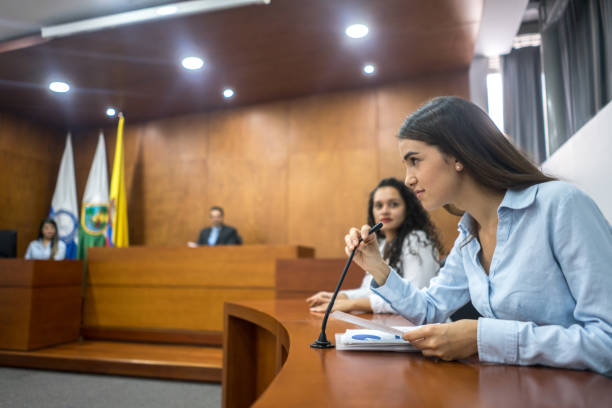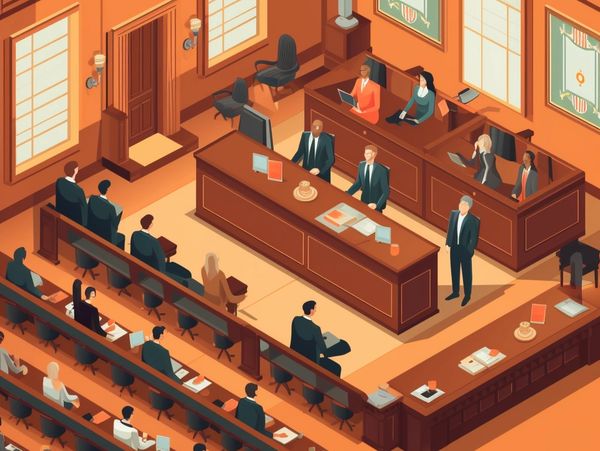Navigating the Complexities of Test Presentations: Tips for Seamless Distribution and Engaging Arguments
In the world of legal process, the art of test discussion stands as a crucial factor of success. As lawyers browse the detailed web of courtroom dynamics, the ability to seamlessly deliver disagreements and evidence while mesmerizing the jury's interest ends up being extremely important. The intricacies intrinsic in trial presentations call for a fragile balance of finesse, technique, and skill. By honing methods that make certain a sleek delivery and crafting engaging debates that resonate with the audience, legal professionals can dramatically enhance their campaigning for. In a globe where persuasion rules supreme, grasping the details of trial discussions is not merely an option but a need for those seeking to dominate in the court room.

Understanding Trial Goals
To efficiently browse a trial, it is crucial to have a clear understanding of the purposes that require to be achieved. Before entering the court room, lawful teams should specify their objectives and preferred end results. These purposes function as assisting concepts throughout the test, forming methods and influencing decision-making processes.
Recognizing trial goals includes a comprehensive evaluation of the situation, legal precedents, and the customer's benefits. Trial Presentations. It calls for a thorough evaluation of the realities, identifying key concerns, and preparing for prospective difficulties. By establishing measurable and particular objectives, lawyers can customize their disagreements and discussions to straighten with the desired outcomes
Additionally, a clear grasp of test objectives makes it possible for legal groups to prioritize evidence, witnesses, and lawful disagreements effectively. It enables the growth of a systematic story that reverberates with the judge and jury, reinforcing the overall instance discussion.

Organizing Proof Properly
Having a clear understanding of trial objectives lays the foundation for organizing evidence successfully in legal process - Trial Presentations. By aligning the presentation of proof with the wanted end results of the trial, lawful teams can strengthen their debates and improve their persuasiveness. One vital element of organizing proof is categorization. Organizing evidence based upon styles or significance to details lawful elements can assist improve the presentation and make complicated information extra absorbable for the court or jury.
Another secret component in arranging proof efficiently is developing a rational circulation. Providing evidence in a systematic and consecutive way can assist construct a compelling narrative that sustains the legal disagreements being made. Additionally, using aesthetic help such as timelines, charts, or graphs can further enhance the organization of proof and aid in clearing up intricate partnerships or series of occasions.
Additionally, ensuring that all proof provided is permissible and pertinent to the instance is necessary. Inadmissible or unnecessary evidence can diminish the toughness of the disagreement and potentially hurt the reliability of the here and now celebration. A thorough testimonial and option procedure must be undertaken to consist view website of just the most lawfully sound and impactful evidence in the test discussion.
Crafting Persuasive Narratives
Crafting engaging narratives plays an essential role in presenting convincing disagreements during lawful proceedings. A well-crafted story has the power to captivate the target market, stimulate emotions, and inevitably guide the choice for today celebration. When creating a narrative for a trial presentation, it is vital to establish a clear storyline that highlights key factors and attaches them in a systematic fashion. Begin by detailing the facts of the instance in an engaging manner, guaranteeing that the sequence of events is simple to comply with. Introduce characters effectively, providing background details that aids the target market understand their inspirations and actions. In addition, including brilliant descriptions and interesting language can bring the narrative to life, making it much more memorable for the discretionary. By weaving with each other proof, testament, and lawful disagreements into a natural and persuasive narrative, legal experts can properly promote for their clients and increase the likelihood of a favorable result in the court.
Understanding Visual Aids
Effective use of visual help is vital to enhancing the impact and quality of test discussions. Visual aids, when utilized tactically, have the power to simplify complicated information, enhance bottom lines, and leave a long lasting perception on the discretionary. To master aesthetic aids in trial presentations, it is vital to make sure that they are clear, concise, and pertinent to the disagreements being made.
When incorporating aesthetic aids, such as charts, timelines, photographs, or charts, into a test presentation, it is necessary to maintain them visually appealing yet professional. The visuals must enhance the verbal arguments, supplying a visual representation of the information being reviewed without frustrating the target market with unnecessary details.
Additionally, experimenting the visual help in advance is imperative to ensure a seamless distribution during the trial. Acquainting oneself with the web content, transitions, and timings of each aesthetic aid visit this web-site can aid maintain the circulation of the presentation and avoid technical problems that might develop.
Supplying Impactful Closing Disagreements
An engaging closing debate functions as the culmination of a test presentation, encapsulating the core narrative and persuading the court and court towards a positive decision. To deliver an impactful closing disagreement, it is critical to succinctly recap crucial factors, highlight the toughness of your case, and attend to any kind of weak points in Recommended Site a critical manner. Begin by describing the primary debates that sustain your client's placement, stressing why the evidence offered throughout the test sustains your narrative. It is important to develop a sense of cohesion and quality, directing the discretionary in the direction of the wanted conclusion.
In addition, including psychological charm can better enhance your closing argument. Ultimately, a well-crafted closing disagreement ought to leave a long-term impression, engaging the court and jury to rule in your customer's support.
Final Thought
Finally, understanding trial discussions entails understanding purposes, arranging evidence, crafting narratives, making use of visual help, and supplying impactful closing arguments. By applying these strategies successfully, legal representatives can provide their instance seamlessly and make compelling debates in the courtroom. It is essential to navigate the intricacies of test presentations with precision and ability to achieve success in lawful process.
By straightening the discussion of proof with the wanted end results of the trial, legal teams can strengthen their debates and improve their persuasiveness (Trial Presentations). To grasp aesthetic aids in trial discussions, it is essential to make sure that they are clear, succinct, and relevant to the debates being made
A compelling closing argument offers as the end result of a trial discussion, enveloping the core narrative and convincing the judge and court in the direction of a positive choice. Begin by laying out the primary arguments that sustain your client's position, highlighting why the evidence offered throughout the trial sustains your story.In final thought, understanding test discussions entails comprehending objectives, arranging evidence, crafting stories, using aesthetic aids, and supplying impactful closing arguments.